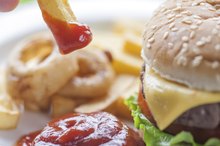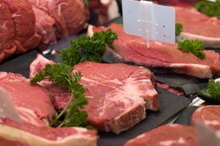The gallbladder is a pear-shaped sac located under the liver on the upper right side of the abdomen, according to MayoClinic.com 12. The liver produces bile—a digestive fluid that aids in the digestion of fat—and the gallbladder stores it. In response to foods, especially fats, the gallbladder releases the bile into the upper small intestine. The gallbladder is not essential to healthy digestion, so removal of the gallbladder rarely causes long-term complications.
Gallbladder Cancer
Removal of the gallbladder, or cholecystectomy, may be indicated in patients who have cancer of the gallbladder, either to remove the cancer or to reduce pain and other symptoms, reports the American Cancer Society. If the cancer has spread outside the gallbladder, more radical surgery may be required.
Gallstones in the Gallbladder
Side Effects of Gallbladder Surgery
Learn More
Gallstones are hardened deposits of digestive fluid that form in the gallbladder, according to MayoClinic.com 12. When gallstones form in the gallbladder--a condition called cholelithiasis--the stones may be tiny in size or as large as golf balls. Some gallstones produce no symptoms and do not require treatment. However, patients who have a severe gallstone attack or several less severe attacks may require nned to have their gallbladder removed.
- Gallstones are hardened deposits of digestive fluid that form in the gallbladder, according to MayoClinic.com 1.
- When gallstones form in the gallbladder--a condition called cholelithiasis--the stones may be tiny in size or as large as golf balls.
Inflammation of the Gallbladder
Cholecystitis--inflammation of the gallbladder--can occur if a gallstone becomes lodged in the neck of the gallbladder, according to the University of Maryland Medical Center. Symptoms include fever and severe pain. Approximately 20 percent of patients with acute cholecystitis require emergency gallbladder removal because of widespread infection or perforation of the gallbladder.
- Cholecystitis--inflammation of the gallbladder--can occur if a gallstone becomes lodged in the neck of the gallbladder, according to the University of Maryland Medical Center.
Gallstones in the Bile Duct
Causes of Pains in My Upper Stomach
Learn More
Gallstones can block the ducts that allow bile to flow from the gallbladder or liver to the small intestine, causing severe pain, jaundice and infection. This condition, called choledocholithiasis, requires immediate medical attention.
Inflammation of the Pancreas
A gallstone that blocks the pancreatic duct—the tube between the pancreas and the common bile duct—can cause inflammation of the pancreas. Pancreatitis is a serious condition that causes intense, constant abdominal pain and often requires hospitalization.
Gallbladder Disease Without Gallstones
Removal of the gallbladder may be necessary when the organ does not empty well, even though no gallstones are present. Chronic acalculous gallbladder disease causes biliary colic, symptoms of which are nausea, vomiting, gas and upper right abdominal pain 1.
Related Articles
References
- MayoClinic.com: Gallbladder Disease
- MayoClinic.com: Gallstones
- National Institute of Diabetes and Digestive and Kidney Diseases. (n.d.). Gallstones. https://www.niddk.nih.gov/health-information/digestive-diseases/gallstones
- University of Maryland Medical Center. (2018). Gallstones and gallbladder disease. https://www.umms.org/ummc/patients-visitors/health-library/in-depth-patient-education-reports/articles/gallstones-and-gallbladder-disease
- Njeze GE. Gallstones. Niger J Surg. 2013;19(2):49-55. doi:10.4103/1117-6806.119236
- Maurer KJ, Carey MC, Fox JG. Roles of infection, inflammation, and the immune system in cholesterol gallstone formation. Gastroenterology. 2009;136(2):425-40. doi:10.1053/j.gastro.2008.12.031
- Halpin V. Acute cholecystitis. BMJ Clin Evid. 2014;2014:0411.
- Balmadrid B. Recent advances in management of acalculous cholecystitis. F1000Res. 2018;7: F1000 Faculty Rev-1660. doi:10.12688/f1000research.14886.1
- Ahmed M. Acute cholangitis - an update. World J Gastrointest Pathophysiol. 2018;9(1):1-7. doi:10.4291/wjgp.v9.i1.1
- Derici H, Kara C, Bozdag AD, Nazli O, Tansug T, Akca E. Diagnosis and treatment of gallbladder perforation. World J Gastroenterol. 2006;12(48):7832-6. doi:10.3748/wjg.v12.i48.7832
- Toouli J. Biliary Dyskinesia. Curr Treat Options Gastroenterol. 2002;5(4):285-291.
- Ahmed M, Diggory R. Acalculous gallbladder disease: the outcomes of treatment by laparoscopic cholecystectomy. Ann R Coll Surg Engl. 2011;93(3):209-12. doi:10.1308/003588411X563402
- Shaffer EA. Gallbladder cancer: the basics. Gastroenterol Hepatol (N Y). 2008;4(10):737-41.
- Wang JK, Foster SM, Wolff BG. Incidental gallstones. Perm J. 2009;13(2):50-4.
- Bree RL. Further observations on the usefulness of the sonographic Murphy sign in the evaluation of suspected acute cholecystitis. J Clin Ultrasound. 1995;23(3):169-72.
- Robinson P, Perkins JC. Approach to Patients with Epigastric Pain. Emerg Med Clin North Am. 2016;34(2):191-210. doi:10.1016/j.emc.2015.12.012
- Pejić MA, Milić DJ. [Surgical treatment of polypoid lesions of gallbladder]. Srp Arh Celok Lek. 2003;131(7-8):319-24.
- Genc V, Sulaimanov M, Cipe G, et al. What necessitates the conversion to open cholecystectomy? A retrospective analysis of 5164 consecutive laparoscopic operations. Clinics (Sao Paulo). 2011;66(3):417-20. doi:10.1590/S1807-59322011000300009
- Katzarov AK, Dunkov ZI, Popadiin I, Katzarov KS. How to measure quality in endoscopic retrograde cholangiopancreatography (ERCP). Ann Transl Med. 2018;6(13):265. doi:10.21037/atm.2018.05.01
- Catalano MF, Thosani NC. (2016). Clinical manifestations and diagnosis of sphincter of Oddi dysfunction. Howell DA (ed). UpToDate, Waltham, MA: UpToDate Inc.
- Lee JY, Keane MG, Pereira S. Diagnosis and treatment of gallstone disease. Practitioner. 2015 Jun;259(1783):15-9,2.
- National Institute of Diabetes and Digestive and Kidney Diseases. (n.d.). Gallstones.
- University of Maryland Medical Center. (2018). Gallstones and gallbladder disease.
Writer Bio
Marcy Brinkley has been writing professionally since 2007. Her work has appeared in "Chicken Soup for the Soul," "Texas Health Law Reporter" and the "State Bar of Texas Health Law Section Report." Her degrees include a Bachelor of Science in Nursing; a Master of Business Administration; and a Doctor of Jurisprudence.









